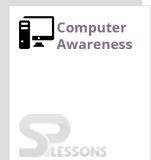 Introduction
Introduction
What is Computer Aptitude?
Computer Aptitude Test is a scientifically validated test designed to measure the aptitude for working with computers. Basically, it measures the ability to solve problems quickly that is essential to truly succeed in every field using computers.
Computers are an integral part of everyday life. Computer aptitude is an important section in many competitive exams primarily related to recruitment. Candidates preparing for banking exams like IBPS PO, SBI PO, and the RBI, must be prepared with Computer Aptitude syllabus.
"A Computer is a device that can be instructed to carry out sequences of arithmetic or logical operations automatically via computer programming". Computers follow a generalized set of operations termed as programs. The programs enable computers to perform an extremely wide range of tasks. Computers are now ubiquitous and are being used in every field of work. Thus, basic knowledge of computers and the ability to operate a computer is now crucial for all job aspirants.
Computer Awareness, also known as Computer Aptitude is one of the prominent sections in various recruitment related competitive exams in India. Computer Awareness Practice Set 9 lists some of the important questions for the preparation of Computer Awareness module. The most significant topics to be learnt for Computer Awareness module are as follows:
- History of Computers
- Computer Fundamentals
- Parts of a Computer System
- Data Processing Cycle of a Computer
- Computer Languages
- Input Devices & Output Devices
- Operating Systems
- Database Management Systems
- Microsoft Office
- Keyboard Shortcuts
- File Extensions
- Networking and Internet
- Computer Viruses
- Important Abbreviations
 Quiz
Quiz
1. Which of the following networking hardware can operate at anyone of the seven layers of the open systems interconnection model?
- A. Router
B. Gateway
C. Switch
D. Modem
- A. Layer 7
B. Data Link Layer
C. Session Layer
D. Transport Layer
- A. Router
B. VPN Connector
C. Switch
D. Hub
- A. Host-based intrusion detection system
B. Housing Intruder Dectection System
C. Host in Device Server
D. None of the above
- A. IDS
B. Load Balancer
C. Switch
D. Hub
1. What is the name given to the electronic device that receives a signal and retransmits it at a higher level?
- A. Hub
B. Repeater
C. Switch
D. HDS
- A. Network Interface Card
B. Network Interface Censorship
C. Node in connection
D. All of the above
- A. LAN Adaptor
B. Network Adaptor
C. Netwrok Card
D. All of the above
- A. Core Router
B. Access Router
C. Edge Router
D. Both B and C
- A. Protocol Translation
B. DHCP Service
C. Network Address Translation
D. All of the above
1. The protocol used by Telnet application is
- A. Telnet
B. FTP
C. HTTP
D. None of the mentioned
- A. default mode
B. server mode
C. line mode
D. none of the mentioned
- A. telnet is a general purpose client-server program
B. telnet lets user access an application on a remote computer
C. telnet can also be used for file transfer
D. none of the mentioned
- A. network layer
B. physical layer
C. transport layer
D. application layer
- A. framing
B. error control
C. flow control
D. channel coding
Other Articles
 Study Guide
Study Guide
| Competitive Exams - Study Guide | ||
|---|---|---|
| Category | ||
| Quantitative Aptitude | Reasoning Ability | General Awareness |
| Computer Awareness | English Knowledge | Banking Awareness |
| General Science | World of Words | Descriptive Test |
 Exams
Exams
| Competitive Exams - College Entrance Exams | |||
|---|---|---|---|
| Category | Notification | ||
| Diploma | NITC New Delhi | ||
| Click Here For – All India Entrance Exam Notifications | |||
 Daily CA
Daily CA
 Job-Alerts
Job-Alerts
 SP Quiz
SP Quiz
| Competitive Exams - Practice Sets | |
|---|---|
| Category | Quiz |
| Quant Aptitude | Permutation and Combination |
| Spotting Errors | |
| Reasoning Ability | Puzzles |
| Insurance Awareness | Insurance Awareness |
 GK
GK
| General Knowledge for Competitive Examinations | |
|---|---|
| Topic | Name of the Article |
| GK - World | Sports Venues |
| Tennis Grand Slam Winners 2017 | |
| GK - India | Indian Stadiums |
| National Sports Awards 2018 | |
| GK - Abbreviations | Insurance Awareness Important Terms |
| Sports Abbreviations | |
| GK - Banking & Insurance | International Financial Institutions |
| First Banking Finance People | |
| GK - Science & Technology | Zoology Terminology |
| Chemistry Terminology | |



